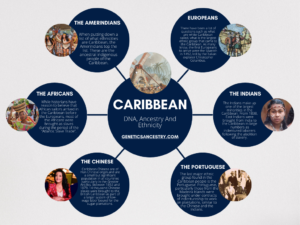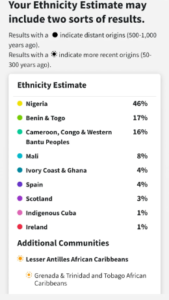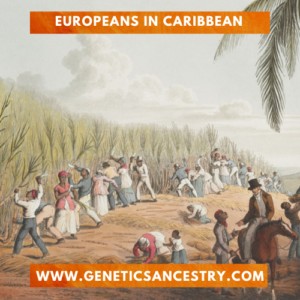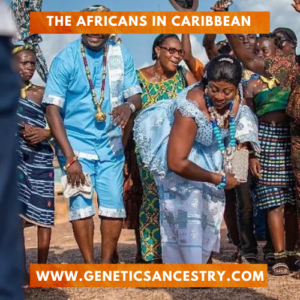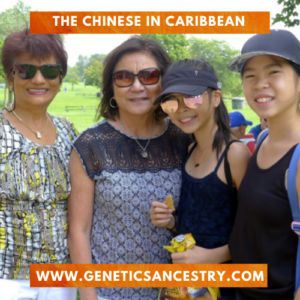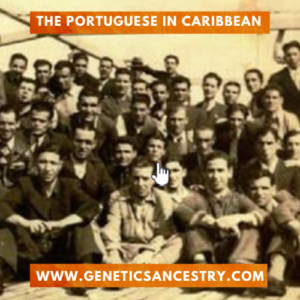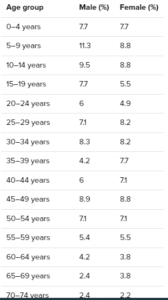Caribbean DNA, Ancestry And Ethnicity
The Caribbean is one of the most ethnically diverse regions of the Western Hemisphere. It is situated around the islands of the Gulf of Mexico and the Caribbean Sea. The Caribbean has a large geographical scope and the ethnicities across the region therefore vary widely too. On a wide scale, a sense of pan–Caribbean ancestry unites all of the Caribbean people but individual backgrounds and ethnic origins differ widely. The people of the Caribbean may be known for their laid-back attitudes and lifestyles but they take their ethnic identities seriously.
What is Caribbean Ethnicity?
Ethnic groups of the Caribbean chose to elevate certain aspects of their ethnic heritage over others, creating complex and often fluid and flexible identities. A scholar of Latin American and Caribbean ethnic studies, Michel-Rolph Trouillot remarked: “Caribbean societies are inescapably heterogeneous…the Caribbean has long been an area where some people live next to others who are remarkably distinct. The region and indeed particular territories within it has long been multi-racial, multi-lingual, stratified, and some would say, multi-cultural.”1. In all this diversity the Caribbean identity is caught up in many contradictions. In this article, we are going to look at the various ethnic identities in the Caribbean.
The main Caribbean islands have been home to immigrants from around the world for centuries, bringing dozens of ethnic groups into contact with each other. So ethnic identity in the Caribbean is rarely a simple matter. It becomes a complex tapestry interwoven with each other. That being said, let’s go through the main contributions to ethnic identities in the Caribbean and break down the various groups and origins of Caribbean ancestry.
The Royal Caribbean Anchor Society is dedicated to the preservation of Caribbean heritage such as where Caribbean ancestors came from. It is a Caribbean ancestry club that keeps information such as Caribbean ancestry DNA and offers services such as Caribbean ancestry search. All ancestry Caribbean records can be found here.
Distribution (%) of Mitochondrial DNA Haplogroups in Caribbean countries.
| COUNTRY | EUROPEAN | AFRICAN | NATIVE AMERICAN |
| CUBA | 26.7 | 28.8 | 34.5 |
| PUERTO RICO | 11.5 | 27.2 | 61.3 |
| JAMAICA | 2.5 | 96.5 | 1 |
| DOMINICA | – | 72 | 28 |
| GRENADE | 14 | 86 | – |
| ST. KITTS | 2 | 98 | – |
| ST. LUCIA | 2.8 | 96.2 | – |
| ST. VICENT | 5.4 | 92.7 | 1.8 |
| TRINIDAD | 8.2 | 87.7 | 4.1 |
Population, by age and sex, for the Caribbean ethnic group, 2018 Census
Here you will find more interesting data related to Caribbean countries Ethnicity.
What are the 6 Ethnic Groups In Caribbean?
-
The Amerindians
When putting down a list of what ethnicities are Caribbean, the Amerindians top the list. These are the ancestral indigenous people of the Caribbean. The indigenous people of Caribbean ancestry cover a large group of distinct tribes and though they are clustered as one ethnicity, they too have a variety of different origins. If you were wondering who were the original people of the Caribbean, most of the main Caribbean islands were inhabited by members of the Carib, Aroak, Tahino, or Sibany groups of indigenous people who migrated from South America.
These groups lived in the Caribbean potentially for hundreds of years before the arrival of the Europeans and had many exchanges with each other including the Mayans and the Aztecs. Unfortunately, diseases, enslavement, and the persecution of these Caribbean ancestors at the hands of early European colonists killed what were most of the people. However, some Amerindians survived and today, descendants of these groups along with other indigenous people are still to be found in pockets of the region.
Most of the remaining indigenous populations of the Caribbean can be found in countries such as Guyana which has approximately 78 thousand indigenous people, Suriname with just about 20 thousand and Dominica with just over 2 thousand. Over the years, however, figuring out what ethnicities are Caribbean does not end here. Ethnic groups in the Caribbean people have become more ingrained in society and can be found on other islands as well, though in very small numbers.
The DNA history of the Iberian Peninsula remains enigmatic due to the numerous complexities involved. This is attributed to the presence of various sub-regions on the map of the Iberian Peninsula. Genetics Ancestry possesses comprehensive knowledge regarding Ethnicity, DNA, and Ancestry.
What is Iberian Peninsula DNA Ethnicity
2. Europeans
Following chronologically the next ethnic group of people we have are those of European descent. There have been a lot of questions such as what are white Caribbean called, what is the largest ethnic group that came to the Caribbean. As many know, the first Europeans to arrive were the Spanish in 1492, led by the Italian explorer Christopher Columbus. Now known as one of the famous Caribbean people, Columbus was searching for a faster way to reach India but found a new world. Soon after, there were Americans in the Caribbean, the Portuguese, the English, the Dutch even the French, all made explorations to the Caribbean and set up colonies where Europeans would make the journey across the Atlantic Ocean with the hope of starting a new life. People of European descent make up the second-largest population in most Caribbean countries. But while Europeans in the early period of colonization made up most of the ethnic groups in the Caribbean islands, they would quickly become overtaken by the next group on our list.
3. The Africans
While historians have reason to believe that African sailors arrived in the Caribbean before the Europeans, most of the Africans were brought as slaves during the period of the “Atlantic Slave Trade”. During the first half of the 16th century, Africans came to work as slaves on plantations. The slaves came mainly from Ghana (Gold Coast), Cote d’Ivoire (often referred to as Ivory Coast), and Guinea. Slavery lasted for more than 300 years and its indescribable inhumane system, from the port of origin to the plantations caused such severe psychological damage that the effects are still evident in our society today.
The impact of slavery and the devastation colonization has had, not only on the Caribbean ancestors but other predominantly black regions such as Africa and the Americas are a topic for further discussion. But the impact that slavery has had and for how long it was, the economic system of the Caribbean has meant that Caribbean of African descent make up the largest group of the Caribbean. Of those Africans who arrived in the Caribbean, nearly half came from two regions. Senegambia, the area comprising the Senegal and Gambia rivers and the land between them or today’s Senegal, Gambia, Guinea Bissau, and Mali; and West Central Africa including what is now Angola, Congo, The Democratic Republic of Congo, and Gabon.
The top five Caribbean countries with the highest concentration of Afro-Caribbean ethnicity can be found in Haiti, with approximately 8.9 million, Cuba 6.9 million, Jamaica 2.2 million The Dominican Republic 2 million and Trinidad and Tobago with just about 460 thousand. With just under 3 million blacks from the Caribbean living in the United States, the Caribbean ethnicity percentage is approximately 90% of blacks in the United States came from these 5 countries Haiti, Trinidad and Tobago, Cuba, The Dominican Republic, and Jamaica.
The Jewish population makes up the majority of Israel’s citizens, with many having Jewish ancestry. The Jewish people have a complex history with a widespread diaspora, get a valuable information about the Israel Ancestry and Genetics on Genetics Ancestry.
What is Israel DNA Ethnicity? | Jewish as an Ethnicity
4. The Indians
The Indians make up one of the largest minorities in the Caribbean. From 1838, East Indians were brought from India to the Caribbean in large numbers as indentured laborers following the abolition of slavery. This labor shortage resulted in the indentureship system in all member states except Barbados and Haiti. Nearly half a million East Indians were brought in to serve under this system, making them the largest group of indentured laborers. Do many people wonder if it is Caribbean and ethnicity or nationality? The number of East Indians brought to the Caribbean was so numerous; that they became the majority of the population in Guyana.
Indians also make up a significant proportion of the population in Trinidad and Tobago and in Suriname as well as the rest of the Caribbean. Trinidad and Tobago has the largest number of Indians, which represent 38% of its population. With over 460 thousand self-identified, Indians in Trinidad and Tobago can trace their ancestors back to Northern India and some Indians from Southern India. In Guyana, the IndoGayanese or East Indians are the largest ethnic group at 44% of the population and they are descendants of indentured laborers from India with over 347 thousand while Suriname with just over 150 thousand represents 27 % of the population. They are followed by Jamaica, Belize, Puerto Rico, and Barbados.
5. The Chinese
Continuing with smaller groups of ethnicities in the Caribbean, we have Caribbean people of Chinese descent. Caribbean Chinese are of Han Chinese origin and are a small but significant population in all countries particularly in the Greater Antilles. Between 1853 and 1879, 14 thousand Chinese slaves were brought to the British Caribbean as part of a larger system of low-wage labor bound for the sugar plantations. These original people settled in three main locations; Jamaica, Trinidad and Tobago, and British Guyana (now known as Guyana) initially working on the sugar plantations.
Most of the Chinese slaves initially went to British Guyana. However, when the program ended in 1879, the population declined steadily mostly due to emigration to Trinidad and Tobago and Suriname which now have large populations of Chinese descendants. Further to this, when the United States enacted the Chinese Exclusion Act in 1882, many Chinese in the United States fled to Puerto Rico, Cuba, and other Latin American and Caribbean Nations and established small niches for themselves in the society. It is no surprise then that the majority of Chinese Caribbean can be found in the Northernmost part of the Caribbean.
Jamaica has the largest population of Chinese Caribbean for example, with approximately 75 thousand people, followed by the Dominican Republic with 60 thousand, and then Cuba with 42 thousand. Smaller populations can be found in Cuba, Jamaica, Hispaniola, and Puerto Rico.
If you have Northwestern European Ancestry and seek absolute confirmation through your DNA, it is essential to thoroughly review your ancestral records.
DNA Ethnicity On Ancestry: Wales, England, And Northwestern Europe
6. The Portuguese
The last major ethnic group found in the Caribbean people is the Portuguese. Portuguese, particularly those from the Madeira Islands were brought under contracts of indentureship to work on plantations, similar to the Chinese and the Indians. Though the number of Portuguese who were brought to the Caribbean as part of this program was significantly less than other minorities, there still were a few thousand who made the journey to the Caribbean countries, which later became their home. The system of slavery did not provide for any entitlement to the slave.
However, the contracts for indentureship included a low fixed wage, housing, and medical attention as well as a grant of land or passage on completion of service. In many other ways, however, indentureship continued as a system of labor exploitation and degradation that began under slavery. There is another system that ran concurrently with the Indentureship system. This system, “The Village System” was mainly used in Guyana and Jamaica. These were ethnic groups in the Caribbean who had been freed and they lived on land that they bought outside the plantations. Beterverwagting, Friendship Village, Plaisance, and Buxton in Guyana, and Sligoville, Kitson Town, Birmingham, and Kensington in Jamaica were established under this system.
At the end of their contracts, the Portuguese, like the Chinese and the Indians, moved to other parts of the Caribbean. Today the largest Portuguese population stayed where they fir emigrated and can be found in countries such as Guyana, Suriname, and Trinidad and Tobago, followed by the ABC Islands which have smaller population centers.
7. Other Ethnicities
As with any region, smaller groups of people have made their way to the Caribbean over the years. These groups may not have come in droves to the Caribbean much like the list of ethnicities listed above but have moved to the region and made the Caribbean their home and became intricate into the culture. For example, there are Americans in the Caribbean, and the Arab community in the Caribbean, while minor, forms a part of the Caribbean diversity. Arabs have made many Caribbean countries their home, with many living in Haiti, Cuba, Trinidad and Tobago, Barbados, Jamaica, and Suriname just to name a few. Some of the oldest purpose-built Mosques in the region can still be found in countries such as Suriname and Barbados.
The Caribbean has a very diverse set of people who have different origins and backgrounds. Although we have different beginnings to the story, we all share a common identity, of being Caribbean first. So one might wonder what are people from the Caribbean called, and the answer would be the Caribbean. One might also wonder what the 3 main ethnic groups. They would be the first three listed above. The culture and influences of Indian people have shaped much of the food that the Caribbean consumes. The impact that Chinese immigrants have had on the Caribbean has shaped the connections the region has with culture. The mixture of African, European, and Indigenous Identities has formed an overarching culture that incorporates every person, no matter their background.
1 Michel-Rolph Trouillot, “The Caribbean Region: An Open Frontier in Anthropological Theory,” Annual Review of Anthropology 21 (1992): 21.
FAQ’s
What is Caribbean DNA ethnicity on Ancestry?
A measure of the percentage of your DNA that is estimated to come from different Caribbean populations.
What populations does Ancestry test for?
Over 20, including African American and African Caribbean communities, Afro-Bermudians, and Afro-Caribbean Peoples of Belize, Honduras & Nicaragua.
How accurate are the estimates?
Accurate, but not perfect.
How do I interpret my results?
Your results are a snapshot of your genetic ancestry. Keep in mind that Caribbean DNA ethnicity is complex and diverse.

